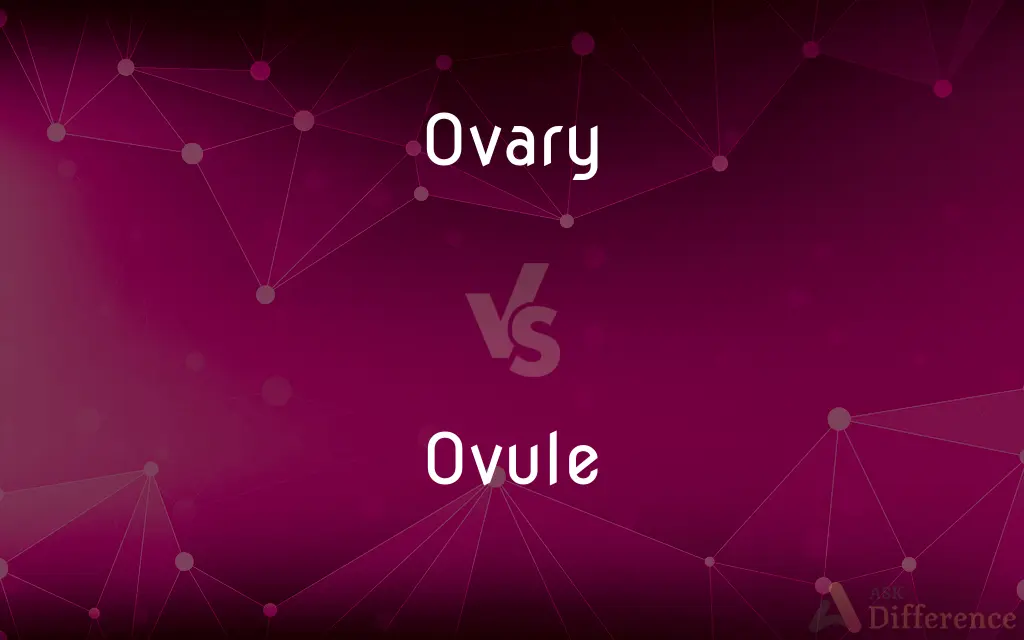Ovary vs. Ovule — What's the Difference?
By Tayyaba Rehman — Updated on September 25, 2023
Ovary is the part of a flower that contains ovules and develops into a fruit; ovule is the part of the ovary that develops into a seed after fertilization.

Difference Between Ovary and Ovule
Table of Contents
ADVERTISEMENT
Key Differences
Ovary and Ovule are fundamental components of plant reproductive systems, but they play distinct roles. The ovary is a part of the flower’s female reproductive organ, the gynoecium, which contains one or more ovules. It is crucial as it undergoes transformations to become the fruit once fertilization occurs, housing the developing seeds. It is an integral part of the plant's reproductive structure, contributing to the propagation of plant species by facilitating the formation of fruits and seeds.
On the other hand, the ovule resides within the ovary and is the structure that, once fertilized by pollen, develops into a seed. It contains the female gametophyte or embryo sac, where fertilization occurs. The ovule's role is pivotal as it holds the necessary genetic information and materials for developing into a new plant under suitable conditions, serving as the starting point for the next generation of plants.
The distinction between ovary and ovule is clear when considering their respective functions in plant reproduction. The ovary acts as a protective chamber, nurturing and housing the ovules, and eventually transforming into fruit. It's the environment where ovules can reach maturation and undergo fertilization securely.
In contrast, the ovule is the entity that actually carries the potential to form a new plant. It’s the recipient of the male gamete during fertilization and undergoes transformations to become a seed. The transformation of the ovule post-fertilization is what ultimately leads to the generation of new plants.
In summary, while both ovary and ovule are interconnected and crucial components of plant reproduction, the ovary serves as the enclosing structure that develops into fruit, and the ovule is the reproductive unit that forms seeds post-fertilization.
ADVERTISEMENT
Comparison Chart
Function
Encloses and protects ovules; develops into fruit.
Develops into a seed post-fertilization.
Location
Part of the gynoecium in flowers.
Located within the ovary.
Role
Facilitates the formation of fruits and seeds.
Holds the genetic information for a new plant.
Development
Transforms post-fertilization to become a fruit.
Transforms post-fertilization to become a seed.
Structure
Larger, enclosing structure.
Smaller, enclosed structure.
Compare with Definitions
Ovary
A larger structure in flowers that serves as an enclosing chamber for one or more ovules.
The tomato’s ovary swells as it begins the transformation into a ripe fruit.
Ovule
A small structure within the ovary that develops into a seed after fertilization.
The ovule contains the genetic material necessary for forming a new plant.
Ovary
The organ responsible for producing ovules and facilitating their maturation and fertilization.
The development of the ovary is crucial for the formation of seeds and fruits in flowering plants.
Ovule
The part of the plant where the female gametophyte or embryo sac is located, facilitating fertilization.
The fertilization of the ovule is the first step in the formation of a seed.
Ovary
The part of a flower that contains ovules and develops into a fruit post-fertilization.
The ovary of the flower will transform into a fruit once the ovules are fertilized.
Ovule
The structure that, post-fertilization, undergoes transformations to become a seed.
Once fertilized, the ovule begins its transformation into a seed, ready to generate a new plant.
Ovary
An integral component of the gynoecium in flowering plants, crucial for plant reproduction.
A healthy ovary is essential for the successful reproduction of flowering plants.
Ovule
The recipient of the male gamete during the process of fertilization in plants.
The male gamete travels to the ovule to achieve fertilization and initiate seed formation.
Ovary
The structure that nurtures and houses ovules until they are fertilized and develop into seeds.
The ovary protects the enclosed ovules and aids in their development into seeds.
Ovule
In seed plants, the ovule is the structure that gives rise to and contains the female reproductive cells. It consists of three parts: the integument, forming its outer layer, the nucellus (or remnant of the megasporangium), and the female gametophyte (formed from a haploid megaspore) in its center.
Ovary
The ovary is an organ found in the female reproductive system that produces an ovum. When released, this travels down the fallopian tube into the uterus, where it may become fertilized by a sperm.
Ovule
(Botany) A structure in seed plants that consists of the embryo sac surrounded by the nucellus and one or two integuments and that develops into a seed after it is fertilized.
Ovary
One of the paired female reproductive organs that produce eggs and female sex hormones in humans and other vertebrates.
Ovule
(Zoology) A small or immature ovum.
Ovary
An analogous gland in an invertebrate animal, such as a flatworm or a mollusk.
Ovule
(botany) The structure in a plant that develops into a seed after fertilization; the megasporangium of a seed plant with its enclosing integuments.
Ovary
(Botany) The ovule-bearing lower part of a pistil that ripens into a fruit.
Ovule
(zoology) An immature ovum in mammals.
Ovary
(anatomy) A female reproductive organ, often paired, that produces ova and in mammals secretes the hormones estrogen and progesterone.
The male testicles are homologous to the female ovaries.
Ovule
The rudiment of a seed. It grows from a placenta, and consists of a soft nucleus within two delicate coatings. The attached base of the ovule is the hilum, the coatings are united with the nucleus at the chalaza, and their minute orifice is the foramen.
Ovary
(botany) The lower part of a pistil or carpel that bears ovules and ripens into fruit.
Ovule
A small body that contains the female germ cell of a plant; develops into a seed after fertilization
Ovary
That part of the pistil which contains the seed, and in most flowering plants develops into the fruit. See Illust. of Flower.
Ovule
A small or immature ovum
Ovary
The essential female reproductive organ in which the ova are produced. See Illust. of Discophora.
Ovule
A reproductive unit in flowering plants, housing the materials and information for generating new plants.
The ovule transforms and develops into a mature seed once fertilization occurs.
Ovary
The organ that bears the ovules of a flower
Ovary
(vertebrates) one of usually two organs that produce ova and secrete estrogen and progesterone
Common Curiosities
What does an ovule develop into?
An ovule develops into a seed after fertilization.
Can there be multiple ovules within one ovary?
Yes, one ovary can contain multiple ovules.
Which part of the plant develops into the fruit?
The ovary develops into the fruit post-fertilization.
Is the ovary a larger structure compared to the ovule?
Yes, the ovary is a larger, enclosing structure that houses the smaller ovules.
Do both ovary and ovule play crucial roles in plant reproduction?
Yes, both the ovary and the ovule play crucial, interconnected roles in plant reproduction.
What does the ovary transform into post-fertilization?
Post-fertilization, the ovary transforms into fruit.
What does the ovary in plants contain?
The ovary contains ovules which develop into seeds post-fertilization.
What is the role of the ovary in plant reproduction?
The ovary's role is to protect and nurture ovules and to develop into a fruit containing seeds post-fertilization.
What is crucial for the ovule to develop into a seed?
Fertilization is crucial for the ovule to develop into a seed.
Does the ovule hold the potential to form a new plant?
Yes, the ovule holds the genetic information and has the potential to form a new plant.
Does the ovule undergo transformations post-fertilization?
Yes, the ovule undergoes transformations to become a seed post-fertilization.
Where is the female gametophyte located in plants?
The female gametophyte is located within the ovule in plants.
Is the ovary responsible for producing ovules?
Yes, the ovary is responsible for producing and housing ovules.
Can there be more than one ovary in a flower?
Yes, some flowers have more than one ovary, each containing ovules.
Is the ovary part of the flower’s female reproductive organ?
Yes, the ovary is a component of the flower's female reproductive organ, the gynoecium.
Share Your Discovery

Previous Comparison
Lynx vs. Axe
Next Comparison
Desert vs. LonelyAuthor Spotlight
Written by
Tayyaba RehmanTayyaba Rehman is a distinguished writer, currently serving as a primary contributor to askdifference.com. As a researcher in semantics and etymology, Tayyaba's passion for the complexity of languages and their distinctions has found a perfect home on the platform. Tayyaba delves into the intricacies of language, distinguishing between commonly confused words and phrases, thereby providing clarity for readers worldwide.














































